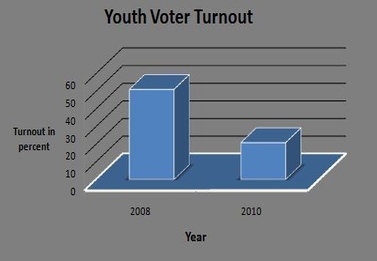 Youth turnout in Nov. 2 elections was lower than that of 2008; many MVHS students did not qualify for the vote
Youth turnout in Nov. 2 elections was lower than that of 2008; many MVHS students did not qualify for the vote
During the 2008 presidential election, the youth, energized by Obama’s campaign and other issues, rushed to the polls to cast their votes. The excitement that motivated the youth two years ago seems to have dissipated this year.
On Nov. 2, the U.S. held its nationwide midterm elections in which citizens voted on various measures and offices. Compared to the presidential election of 2008, the voter turnout for the midterms dropped significantly, particularly among those between the ages of 18 and 29.
 According to The Center for Information and Research on Civic Learning and Engagement of Tufts University, only 20.9 percent of eligible youth voters from the ages of 18 to 29 turned out on Nov. 2. In contrast, CIRCLE wrote that 51.1 percent of the same age group voted in the 2008 presidential elections. Cokie Roberts, an ABC News political analyst, noted that the electorate of Nov. 2 was generally older than that of 2008. Editorial director of the National Journal Ron Brownstein commented that the relatively lower number of young voters may have contributed to the thrashing that the Democrats received, as they relied on the country’s youth in 2008. Such reasoning is supported by CIRCLE’s statement that 60 percent of youth voters said they approved of Obama, while only 54 percent of all voters were content with him.
According to The Center for Information and Research on Civic Learning and Engagement of Tufts University, only 20.9 percent of eligible youth voters from the ages of 18 to 29 turned out on Nov. 2. In contrast, CIRCLE wrote that 51.1 percent of the same age group voted in the 2008 presidential elections. Cokie Roberts, an ABC News political analyst, noted that the electorate of Nov. 2 was generally older than that of 2008. Editorial director of the National Journal Ron Brownstein commented that the relatively lower number of young voters may have contributed to the thrashing that the Democrats received, as they relied on the country’s youth in 2008. Such reasoning is supported by CIRCLE’s statement that 60 percent of youth voters said they approved of Obama, while only 54 percent of all voters were content with him.
Nonetheless, this year’s youth turnout is comparable to that of previous midterm elections. CIRCLE reported that 23 percent of eligible youths voted in the 2006 midterms, and 20 percent turned out in 2002. ABC News confirmed CIRCLE’s reports, stating that midterms typically have lower youth turnouts than presidential elections. Given the upsurge of young voters in 2008, however, some expected that a larger percentage of them to vote on Nov. 2 as well.
In order to increase the percentage of youth voters, teachers at MVHS have been encouraging seniors to register to vote. Government teacher Christopher Chiang helped organize a mock election for students, in which they campaigned for measures and voted for those that they supported. Government teacher Benjamin Recktenwald also encourages students to register for the vote by giving 18 year-old citizens registration forms, which he keeps in a large box in his classroom.
Yet, according to Recktenwald, part of the problem of getting students to register is citizenship.
“One problem I think that we have at [MVHS] that probably is not very common in a lot of high schools around the country, is that there is a large number of students here who aren’t citizens,” Recktenwald said. “If you’re going to talk about voting, citizenship is an issue.”
Another problem that obstructs a student’s ability to vote is simply being 18. Not many students meet the age requirement for voting by November, and are consequently unable to participate in the elections. Senior Japheth Wong filled out his registration form as soon as he turned 18; however, his birthday fell nine days after the election.
According to Recktenwald, only about five of his 170 students were eligible to vote on Nov. 2. At MVHS, it seems, age and citizenship, not interest, barred students from voting.
{cc-by-nc}








